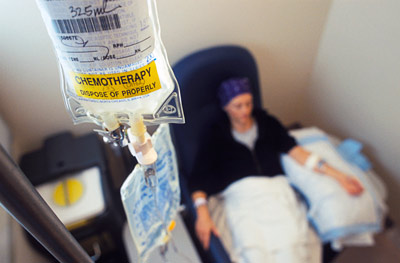May 18, 2021 Research Highlight Chemistry
Activation of prodrug using protein-encased gold catalyst
Anticancer drugs could be generated at tumors by the reaction of a prodrug with a gold catalyst in a protein scaffold
 Figure 1: Conventional chemotherapy drugs target all rapidly dividing cells, which causes them to have a range of side effects, including hair loss. By encasing a gold catalyst in human serum albumin, RIKEN chemists have come up with a strategy that could be used to produce prodrugs that only become active at the target site and hence minimize side effects. © SAM OGDEN/SCIENCE PHOTO LIBRARY
Figure 1: Conventional chemotherapy drugs target all rapidly dividing cells, which causes them to have a range of side effects, including hair loss. By encasing a gold catalyst in human serum albumin, RIKEN chemists have come up with a strategy that could be used to produce prodrugs that only become active at the target site and hence minimize side effects. © SAM OGDEN/SCIENCE PHOTO LIBRARY
As part of their efforts to devise ways to minimize the side effects of drugs for treating cancer, four RIKEN chemists have found a biocompatible way to convert compounds with low biological activity into anticancer drugs at tumors1.
Chemotherapy is one of the many strategies for treating cancer. However, many chemotherapy drugs produce unwanted side effects because in addition to attacking cancer cells, they cause collateral damage to healthy cells. One strategy for minimizing side effects is to use a prodrug—an inactive compound that is converted into an active drug on undergoing a chemical reaction at the target site. For clinical use, prodrugs and the reaction to synthesize the free drug must be biocompatible and occur at the desired site.
Now, Katsunori Tanaka, Tsung-Che Chang, Kenward Vong and Tomoya Yamamoto, all at the RIKEN Biofunctional Synthetic Chemistry Laboratory, have devised a biocompatible route to produce phenanthridinium-based drugs.
The RIKEN team initially used a gold(I)-complex as the catalyst to form the drugs, which were effective at killing cancer cells in the lab. However, under physiological conditions, the gold(I)-complex and the metabolite, glutathione, underwent a reaction that caused the gold catalyst to lose its catalytic activity.
To make this prodrug strategy biocompatible, Tanaka and co-workers shielded the gold catalyst from glutathione by encasing the catalyst within the protein human serum albumin.
“The gold artificial metalloenzyme acts as a trigger to activate the prodrug so that the active drug is synthesized via hydroamination,” explains Tanaka. “Hydroamination is not catalyzed by any known naturally occurring enzyme, and so the prodrug should only become active under physiological conditions when catalyzed by the gold artificial metalloenzyme.”
The researchers found that the albumin-based gold artificial metalloenzyme protects the catalytic activity of the bound gold catalyst from biomolecules such as glutathione and cell lysates, and reduces the cytotoxicity of the gold catalyst. When encased within albumin, the gold-mediated drug synthesis occurred in vitro even in the presence of relatively high levels of glutathione. “The gold artificial metalloenzyme enables an organic reaction to synthesize drugs in a biological environment,” says Tanaka.
In order to translate this prodrug strategy to the clinic, the researchers envisage combining the artificial metalloenzyme with a drug-delivery system based on glycoalbumin that has been previously developed by the RIKEN team.
“We hope this glycosylated gold artificial metalloenzyme will be able to achieve drug synthesis locally within tumor tissues, while minimizing unnecessary drug interactions with healthy tissues,” says Tanaka.
Related contents
- Gold-catalyzed reaction releases an active drug to kill cancer cells
- Using the RIKEN click reaction to weaponize antibodies against cancer
- Drug production inside our bodies
Reference
- 1. Chang, T.-C., Vong, K., Yamamoto, T. & Tanaka, K. Prodrug activation by gold artificial metalloenzyme‐catalyzed synthesis of phenanthridinium derivatives via hydroamination. Angewandte Chemie International Edition advanced online publication March 2021 doi: 10.1002/anie.202100369
